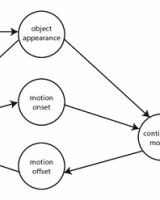A clustering-based method to estimate saliency in 3D
animated meshes
Abdullah Bulbul1 Sami Arpa2,3 Tolga Capin4
1Vision Science Graduate Group, University of California at Berkeley, Martin Banks' lab, 360 Minor Hall, Berkeley, CA 94720, USA
2Department of Computer Engineering, Bilkent University, Turkey
3School of Computer and Communication Sciences, EPFL, Switzerland
4Department of Computer Engineering, TED University, Turkey

Abstract
We present a model to determine the perceptually significant elements in animated 3D scenes using a motion-saliency method. Our model clusters vertices with similar motion-related behaviors. To find these similarities, for each frame of an animated mesh sequence, vertices׳ motion properties are analyzed and clustered using a Gestalt approach. Each cluster is analyzed as a single unit and representative vertices of each cluster are used to extract the motion-saliency values of each group. We evaluate our method by performing an eye-tracker-based user study in which we analyze observers׳ reactions to vertices with high and low saliencies. The experiment results verify that our proposed model correctly detects the regions of interest in each frame of an animated mesh.
Materials
Citation
Bulbul, Abdullah, Sami Arpa, and Tolga Capin.
A clustering-based method to estimate saliency in 3D
animated meshes.
Computers & Graphics 43 (2014): 11-20.
@article{bulbul2014clustering,
title={A clustering-based method to estimate saliency in 3D animated meshes},
author={Bulbul, Abdullah and Arpa, Sami and Capin, Tolga},
journal={Computers \& Graphics},
volume={43},
pages={11--20},
year={2014},
publisher={Elsevier}
}Related papers
 |
S. Arpa, A. Bulbul and T. Capin. A
decision theoretic approach to motion saliency in computer animations.Motion
in Games, Edinburgh, UK, 2011.
|
Acknowledgements
The horse and camel gallop animations were made available by Robert Sumner and Jovan Popović from the Computer Graphics Group at MIT. The hand, toaster, fairy, and running human (Ben) models were obtained from The University of Utah 3D Animation Repository. Dance model is available at Khaled Mamou׳s website (http://khaledmammou.com/). We are grateful to Rana Nelson for proofreading and suggestions. Also, we would like to thank all subjects who participated in the experiments. This work is supported by the Scientific and Technical Research Council of Turkey (TUBITAK, Project number: 110E029) and performed when the authors were at Computer Engineering Department of Bilkent University.
